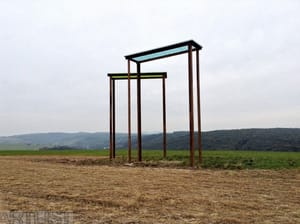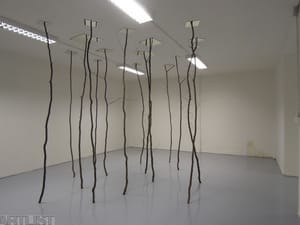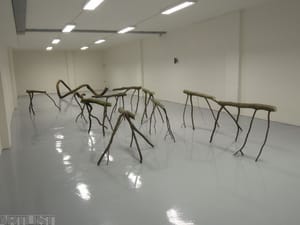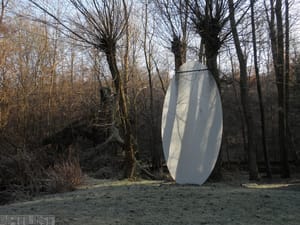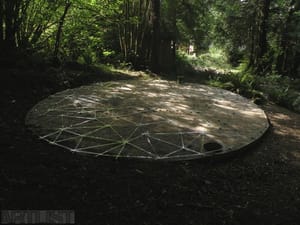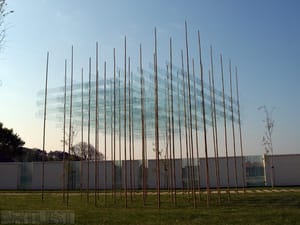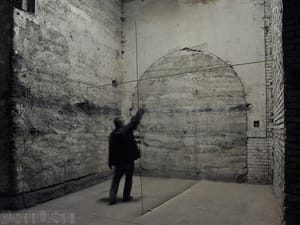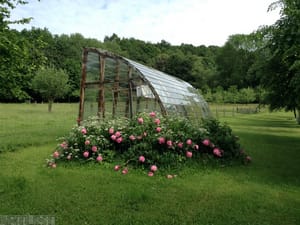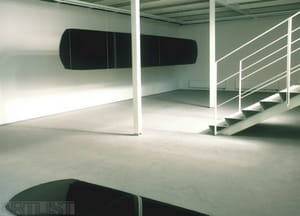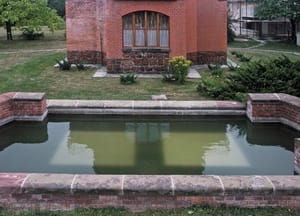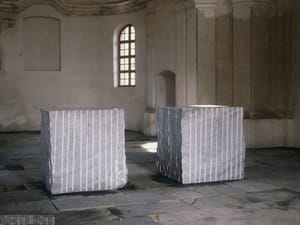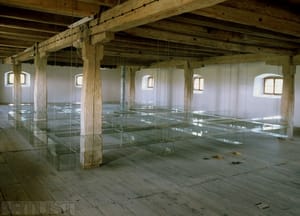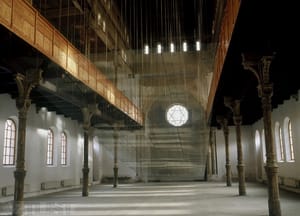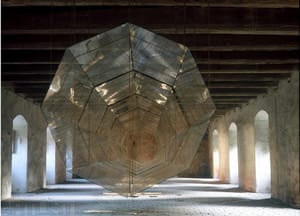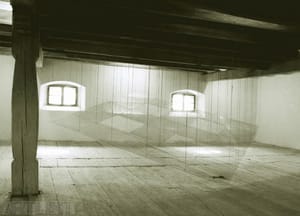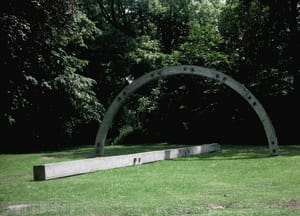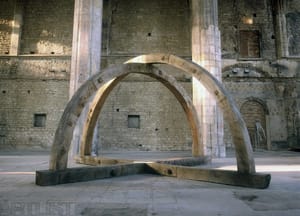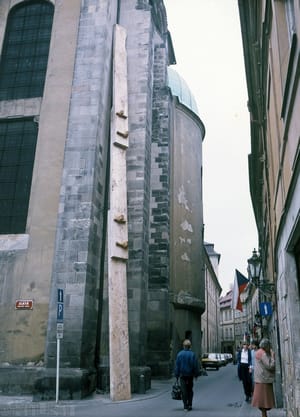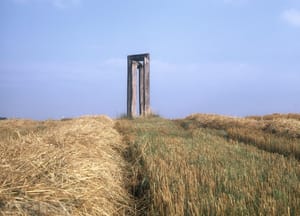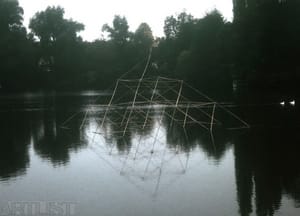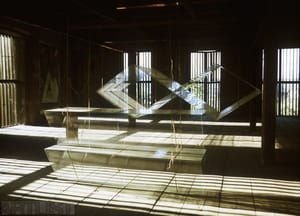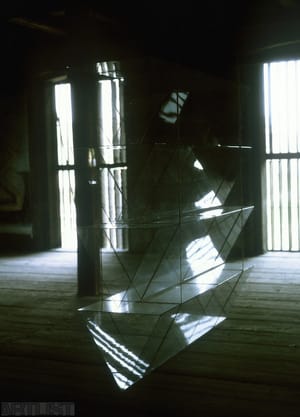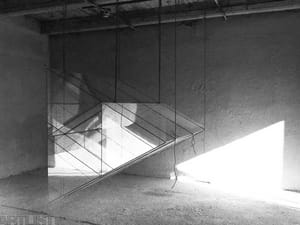- First Name
- Jan
- Surname
- Ambrůz
- Born
- 1956
- Birth place
- Zlín
- Place of work
- Šarovy
- CSU Library
- ↳ Find in the catalogue
About artist
Jan Ambrůz graduated from the Academy of Arts, Architecture and Design in 1984. He gained a name for himself at Confrontation VII in Svárov in 1987, where he exhibited a geometrical construction made of dry plant stalks and cords on the surface of a local village pond. His interest in geometry took over from that in figural sculpture, which had marked the beginnings of his creative work.
A tendency toward constructive solutions minimised into basic geometrical forms has characterised his sculptures since that time. Since the 1980s, Ambrůz’s work has developed in two directions: one is focused on delicate constructions and installations made of sheets of glass, the other on work with wood. In both of these lines the artists reshapes in an innovative way the legacy of geometrical art and minimalism, as well as land art in certain works, since the placing of a work within a natural landscape plays an important role in Ambrůz’s work.
Many objects are created purely for a given place and time. After an installation comes to an end such a work subsequently only exists in the form of photographic documentation. Since 1988, Ambrůz has created a large series of glass constructions, large objects made of sheets of glass, laid on the ground or on an unstable wooden base, or hung feely in space using string (Infinity, 1987, Below One Another, 1987, Trio, 1987). The composition using sheets of glass gives rise to geometric grids in which one geometric motif is repeated. Basically, this involves the principle of multiplication as we know it from minimalism. However, Ambrůz adds an emotional charge by monitoring the relationship of the material (glass), light and air. These delicate, ephemeral and subtle, while at the same time monumental glass constructions levitate in space and force us to ask whether and if so how apparent instability can hold its own in the face of the laws of gravity. These sculptures accentuate the relationship between instability and stability and between mass and the denial thereof.
Along with glass sculptures Ambrůz began creating monumental wooden sculptures-constructions, from the start placed directly in the landscape (in specifically recommended places) and later in interiors (Cross, 1989, There, 1990, Vault, 1991). These are simple, geometrically shaped objects constructed from wooden beams processed using a chainsaw. Their lapidary, “uncultivated” character, almost like that of an unprocessed raw material, in combination with the landscape, distances them from cold geometry and they take on an almost ritualistic significance. It is as if they refer to totemic symbols, signs and figures, a kind of resuscitation of prehistory and its archetypes within today’s technical world.
In the 1990s, Amrůz discovered a new material, iron. He created a series of installations in which he placed iron plates in various shapes on the ground. In several of these works he used maximally reduced geometric forms. He restricted the language of geometry to its basic elements: circle, square, and rectangle. In these works he was closest to the tradition of classical geometrical art (Circles, Squares, 1995), though in certain installations he again deliberately violated the geometric precision: the edges of the iron plates are ragged or bent (Untitled, 1995).
Marble has featured in the artist’s work since the 1990s. Again, these are “floor” sculptures, in which the artist achieves special light effects through the different ways of polishing the surface of the marble or by placing individual parts against each other. However, Ambrůz did not completely give up working with glass in the following years. For instance On Cones I and II (2009), in which sheets of glass are spread out in a forest, demonstrates his love of landscape projects.
A characteristic feature of Ambrůz’s work is a special poetics which arises from the dialogue of object and environment, in which when the surrounding space becomes part of the installations. The language of geometry pervades the artist’s work, though this is a different language from that which we are used to from previous geometric and minimalist art. Strict successions, cold technical processing and a clear construction are always violated and “softened” in Ambrůz’s work, at one moment by the instability of the glass installations, at another by the primitivism of the surface of wooden or iron objects. An unsettling tension thus creeps into the artist’s sculptures, testimony to the transience and temporariness of things and to the paradox of life itself.
- Author of the annotation
- Ivona Raimanová
CV
Studies:
2001 Second Doctorate at the Academy of Fine Arts, Architecture and Design, Prague
1998 Professor at the Faculty of Fine Arts, Brno University of Technology, Brno
1978-1984 Academy of Fine Arts, Architecture and Design, Prague (Design Studio - Zlín)
1974-1978 studies at the Secondary School of Applied Arts, Uherské Hradiště
Awards and scholarships:
2009
Artists in Residence, Pilchusk Glass School, Seatle, USA
2008
Grant fondu kultury zlínského kraje
2008-2009
Stipendium Ministerstva kultury České republiky, Grant Státního fondu kultury, Česká republika
2000
Grant Pollock Krasner Foundation, New York, USA
Stipendium für Steinbildhauer, EXPO 2000 Hannover, D
1996
Grant Sorosova centra současného umění v Praze
1994
Grant Pollock-Krasner Foundation, New York, USA
1991-1993
Wilhelm Lehmbruck-Stipendium, Duisburg, D
1990
Grant Pollock-Krasner Foundation, New York, USA
Exhibitions
- Solo exhibitions
-
2003
Sklo, Galerie Šternberk, Šternberk
Opaque, Galerie ARS, Brno
2001
Čtvero ročních období, Kostel sv. Václava, Dům umění, Opava
1999
Kov, sklo, kámen, prostor, Galerie výtvarného umění, Ostrava
Jan Ambrůz - instalace, Galerie Langův dům, Frýdek-Místek
1998
Galerie Behémót, Praha
Rožnovské sochařské léto 98, MK Galerie , Rožnov pod Radhoštěm
Objekty,dokumentace,Městskáknihovna,Rožnov pod Radhoštěm Radhoštěm
1997
O lehkosti a tíži, Galerie Sýpka, Vlkov
Kostel Povýšení sv. Kříže, Moravský Beroun
1996
Kresby, Dům umění, Brno
Fotodokumentace, Knihkupectví Archa, Zlín
Galerie Panacea, Valašské Meziříčí
1995
Sokolská 26, Ostrava
Mezi černou a bílou, Galerie Via art, Praha
1992
Park Vreud en Rust, Voorburg, NL
1991
Sochy na náměstí, Hranice
1989
Galerie mladých, Brno
1988
Galerie pod podloubím, Olomouc
- Group exhibitions not included in ARTLIST.
-
2011
Šestý Nový zlínský salon, KGVU, Zlín
2010
USAS2/2, Malá Amerika, Brno
2009
Crossing Borderes,Glassmuseet Ebeltoft, DK
USAS2, Malá Amerika, Brno
2006
SPKH 2007, Urban centrum, Brno
2004
Folklorismy, České muzeum výtvarných umění v Praze
Nová místa, Dům umění, Opava
2003
Ornament, Galerie moderního umění, Hradec Králové, Galerie města Plzně
2002
Monochromie, České muzeum výtvarných umění, Praha
ART PRAGUE 2002, Mánes, Praha
Ambrůz, Kvíčala, Malovaný dům, Třebíč
2001
From the Czech Republic,Tunel exhibition space, Prague
Barevná socha,Severočeská galerie výtvarného umění, Litoměřice
Klub konkrétistů 2 Brno, Muzeum města Brna, Brno
2000
Umělecká Beseda 2000, Mánes, Praha
Emöke Vargová, Jan Ambrůz, Synagóga Šamorín, SK
Quadrat, Galerie Bielska BWA, Bielsko Biala, PL
Melancholie, Moravská galerie, Brno
1999
Sympozium železné plastiky 1998, Veletržní palác, NG Praha
Pohyb kolem středu, Galerie Caesar, Olomouc
Klub konkretistou, Slovenská národná galéria, Bratislava
Nový zlínský salon 99, Zlín
Kunst op de Helling, Lochem, NL
Jan Ambrůz, Václav Krůček, Dům umění, České Budějovice
FaVU - současná tvorba, Dům umění, Brno
1998
Bílá, Nová síň, Praha
Laboratorium 98, Vyšné Ružbachy, SK
Kámen a hvězdy, Hvězdárna Ondřejov
Pohyb kolem středu, Dům umění, Brno
Sochaři Umělecké Beseda, Zámecké nádvoří, Hranice na Moravě
Umělecká Beseda 1998, Mánes, Praha
1997
Ambrůz, Tichý, Kaple, zámek Kačina
Malík, Krůček, Ambrůz, Galerie Aspekt, Brno
Umělecká Beseda 97, Mánes, Praha
1996
FINEART 96, Valdštejnská jízdárna, Praha
Ticho pro dvanáct hlasů,Moravská galerie, Brno, Dům U kamenného zvonu, GHMP Praha
Ambrůz, Tichý, Kaple, zámek Kačina
Nový zlínský salon 96, Zlín
Zpřítomnění, Galerie Klatovy-Klenová
1995
Umenie aury I, Synagoga, Trnava
Jan Ambrůz, Petr Kvíčala, České muzeum výtvarných umění, Praha
Pars pro toto, Slovenská národná galéria, Bratislava
J. Ambrůz a P. Kvíčala, Galerie JNJ, Praha, Bidýlko, Brno
Ze současné tvorby - 90. léta, Dům umění, Zlín
Umělecká Beseda 95, Mánes, Praha
6. Triennale Kleinplastik, Sudwest LB forum, Stuttgart, D
1994
Chatrný, Ambrůz, Kvíčala, Galerie Trigon, Plzeň
Záznam nejrozmanitějších faktorů, Jízdárna Pražského hradu, Praha
4 x 10, Schmalkalten, Passau, Klatovy-Klenová, Trnava, SK
Přírůstky, Galerie Sýpka, Vlkov
S.O.F.A.Art Event Nyborg 1994, Nyborg, DK
Valdštejnská zahrada, Praha
Artcircola, zámek Hořín, Hořín-Mělník
Situace Brno, Knoll Galéria, Budapest, H
Fungus, Plasy
1993
První Sýpka, Galerie VŠUP, Praha
Wilhelm Lehmbruck-Stipendiaten 1991-93,Wilhelm Lehmbruck Museum, Duisburg
Trienále Ceny Jindřicha Chalupeckého, Galerie Sýpka, Vlkov
Šedá cihla 34/93, Galerie Klatovy-Klenová
Pardubické valy, Východočeská galerie, Pardubice
Přírůstky, Galerie Sýpka, Vlkov
Galerie Aspekt, Brno
Umělecká Beseda 93, Dům umění, Brno
1992
Situace 92, Mánes, Praha
Duch a světlo, Expo 92, Sevilla, Galerie Sýpka, Vlkov
České výtvarné umění 1960-90, Středočeská galerie, Praha
Možnosti drobné plastiky, Dům umění, Brno
Sochařství 1988-92, Dům U kamenného zvonu, Praha
Skulpturenprojekt Gotha, Schloss Friedenstein, Gotha,
Art Cologne, Köln, D
1991
Laureáti Ceny Jindřicha Chalupeckého, Galerie V. Špály, Praha
Nahroubeno, Galerie Sýpka, Vlkov
Prostor 91, Zlín
Jiná geometrie, Mánes, Praha
Hořící keř, Emazský klášter, Praha
V dimenzích prázdna, Roudnice nad Labem, Karlovy Vary, Pardubice, Olomouc
Ohne Distanz, Akademie der bildende Kunste, Wien, A
1990
Česká malba a plastika 80. let, České kulturní centum, Budapest, H
Z tvorby mladých výtvarníků, Dům umění, Zlín
Sommeratelier, Hannover, H
Prague in Eindhoven, Eindhoven, Amsterodam, NL
AN 90, Koln-Nippes, D
Galerie u Řečických, Praha
1989
Sdružený klub ROH, Uničov
OL 13-89, Prostějov
5. bienále mladých výtvarníků, Dům umění, Brno
1988
Miedzynarodowe triennale sztuki, Majdanek, PL
1987
Konfrontace VI, Praha-Vysočany
Setkání-Vesmír, Galerie H, Kostelec nad Černými lesy
Objekt-Voda, Hranice
Konfrontace VII, Svárov
Art of Today II, Budapest, H
- Collections
-
Východočeská galerie, Pardubice
Národní galerie, Praha
Schlossmuseum, Gotha
Wilhelm-Lehmbruck Museum, Duisburg
Gemeindepark, Voorburg
Galerie Klatovy-Klenová
Moravská galerie, Brno
- Other realisations
Art in architecture and public spaces:
2006-07 Kytice (Bouquet), object on the TGM Square, Třinec
2005-06 TGM Monument, Hustopeče near Brno
1995 Brána borců (The Gate of Athletes), completion of the Masaryk University faculty, Brno
Monography
- Monography
Tina Oldknow: 25 years of New Glass Review, The Corning Museum of Glass, New York 2005
Alena Potůčková: Folklorismy, České muzeum výtvarných umění, Praha 2004
Finfrlová Petra: Ornament, Galerie moderního umění, Hradec Králové 2003
Valoch Jiří: Čtvero ročních období, Dům umění, Opava 2001
Netopil Pavel: Kov, sklo, kámen, prostor, GVUO Ostrava 1999
Ševeček Ludvík: Nový zlínský salón 1999, Dům umění, Zlín
Wim van der Beek: Kunst op de Helling, Stichting dag Lochem 1999
Ruler Tomáš: FaVU - současná tvorba, FaVU Brno 1999
Valoch Jiří: Pohyb kolem středu, DU Brno 1998
Boháčová Yvonna: 10 sochařů UB, Muzeum Hranice 1998
Koleček Michal: Sympozium železné plastiky 1998, Veletržní palác, NG Praha 1998
Beskyd Ladislav: Laboratorium 98, Vyšné Ružbachy
Valoch Jiří: Sklo, Galerie Sýpka 1997
Raimanová Ivona: FINEART 96, Valdštejnská jízdárna, Praha 1996
Krkošková Alena: Ticho pro dvanáct hlasů, MG Brno 1996
Valoch Jiří: Jan Ambrůz 1986-1996, Dům umění, Brno 1997
Halířová Marie: Zpřítomnění-Přírustky galerie z let1987-1996, GalerieKlatovy
Lang Čestmír: Jan Ambrůz, Galerie Sokolská 26, Ostrava 1995
Zemánek Jiří: Fungus 1145-1996, Nadace Hermit, Plasy 1995, str. 49
Rusinová Zora: Pars pro toto, Slovenská národná galéria, Bratislava 1995
Potůčková Alena: Jan Ambrůz, České muzeum výtvarných umění, Praha 1995
Geržová Jana: Umenie aury I, Synagoga-centrum súčasného umenia, Trnava 1995
Zemánek Jiří: Jan Ambrůz a Petr Kvíčala, Galerie Na bidýlku, Brno 1995
Sedláček Ivo: Ze současné tvorby - 90. léta, DU Zlín 1995
Záznam nejrozmanitějších faktorů, Jízdárna Pražského hradu, Praha, 1994
Museum Duisburg 1993 (s. 7 Ch. Brockhaus)
Šedá cihla 34/93, Galerie Klatovy - Klenová, 1993
Mandýsová Hana: Pardubické valy 93, Východočeská galerie, Pardubice, 1993
Vojtěchovský Miloš: J. Ambrůz, Gemeente Voorburg 1992
Wittlich Petr: Situace 92, Mánes, Praha 1992
Nedoma Petr: Duch a světlo, 1992
Leinz Gotlieb: Skulpturenprojekt Gotha 1992, str. 105
Lang Čestmír: Wilhelm-Lehmsbruck Sttipendianten 1991-93
Nešlehová Mahulena: Laureáti Ceny Jindřicha Chalupeckého, Galerie V. Špály, Praha 1991
Ševčíkovi Jana a Jiří: Ohne Distanz, Akademie der bildende Kunste, Wiena 1991
Ševeček Ludvík: Prostor 91, Dům umění, Zlín 1991
Hlaváček Josef: Jiná geometrie, Mánes, Praha 1991
Nedoma Petr: Hořící keř, Emauzský klášter, Praha 1991
Vlček Tomáš: V dimenzích prázdna, Galerie výtvarného umění, Roudnice nad Labem, 1991
Valoch Jiří: AN 90, Ausbesserungswerke DB, Koln-Nippes 1990
Valoch Jiří: J. Ambrůz, Galerie mladých, Brno 1989,
Boháčová Yvonna: OL 13-89, Muzeum, Prostějov 1989
Boháčová Yvonna: Jan Ambrůz - Objekty, Galerie pod podloubím, Olomouc 1988
- Articles
Valoch Jiří: Výstava sochařského atelieru Jana Ambrůze, Atelier 14/2006
Ondračka Pavel: Folklorismy, Výtvarná výchova, 4/2004
Weber Milan: Kov, sklo, kámen a prostor Jana Ambrůze, Atelier 8/1999
Netopil Pavel: Program Galerie výtvarného umění v Ostravě (leden-březen 1999)
Valoch Jiří: Koncepty Jana Ambrůze a Václava Krůčka, Ateliér 19/1999
Potůčková Alena: Ostravská galerie mění tvář, Ateliér 22/1999
Pospěch Tomáš: Den a noc, Atelier 21/1998
Surůvka Jiří: Laboratorium 98 Vyšné Ružbachy, Umělěc 9/1998
Kosková Petra: Mimo rozměr, Domov 11/1998
Valoch Jiří: Ambrůz v několika médiích, Atelier 22/1997
Valoch Jiří: V Aspektu třikrát reduktivně, Atelier 22/1997
Freisleben Zdeněk: Nový Výstavní prostor, Atelier 15/1996
Daněk Ladislav: Olomoucký okruh, Výtvarné umění 1-2/1996 s. 208-209
Šálková Jana: Ambrůz a Kvíčala, Ateliér 6/1995 s. 6
Zemánek Jiří: Jan Ambrůz a Petr Kvíčala, Atelier 9/1995
Mojžíš Juraj: Meno, miesto, priestor a čas, Atelier 9/1995
Rusinová Zora: Hladanie aury, Galéria 1/1995
Pachmanová Martina: Mezi černou a bílou, Literární noviny 45/1995
Netopil Pavel: O počátcích Ambrůzovy tvorby, Bulletin Moravské galerie 1994
Geržová Jana: Fungus v Plasoch, Profil 8-10/1994 s. 52
Valoch Jiří: Ambrůz v Aspektu, Atelier 20/1993
Valoch Jiří: Jan Ambrůz, Atelier 4/1991
Boháčová Yvonna: K tvorbě Jana Ambrůze, Výtvarné umění 4/1990
Hůla Jiří: Jan Ambrůz, Gramorevue 9/1989
Boháčová Yvonna: Hledání kontinuity, Architekt 8/1988

